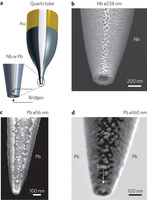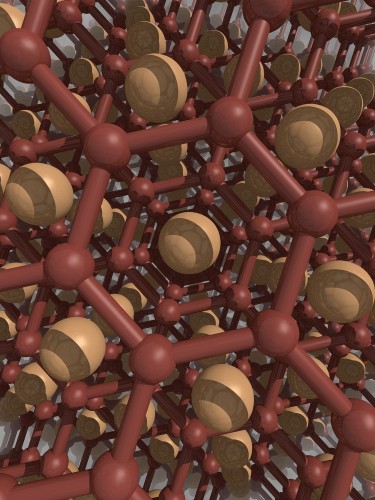The scientists of the institute created a device for measuring magnetic fields, which breaks the records of sensitivity and accuracy

Weizmann Institute of Science scientists have taken an important step towards understanding the fascinating phenomenon of superconductivity: They managed to create The smallest SQUID device (a device used to measure magnetic fields) ever, which breaks the records of sensitivity and resolution. The sensitivity of the device, known as "nano-SQUID on a needle" is so high that it is able to distinguish the magnetic field of a single electron - the "holy grail" of the field of magnetic imaging.
Superconductivity is a quantum phenomenon that occurs at extremely extreme temperatures. When certain materials are cooled to very low temperatures, the "magic" happens: they lose all resistance to the passage of an electric current through them, and magnetic fields are repelled from them. These extraordinary properties allow, among other things, the construction of trains that float above their tracks (almost without friction), the acceleration of particles to a speed close to the speed of light, and the scanning of the human body with MRI devices for the purposes of diagnosis and medical treatment. Superconductors are also the basis for the creation of SQUID devices (acronym for Superconducting QQuantum Interference Device), which enable the study of the phenomenon of superconductivity. Although discovered over a century ago, scientists still do not fully understand the underlying physics of superconductors.
In contrast to optical microscopy, which is based on light rays and lenses for the purpose of magnifying small samples, scanning microscopy uses a probe of some kind that is moved over a sample to measure a certain property at different points. An example of this is creating a thermal map of the palm by moving a thermometer and measuring the temperature at several points on its surface. In this case the probe is a nano-SQUID that measures the strength of the magnetic field at different points over a sample.
Besides the challenge of the sensitivity required from the SQUID devices, to produce high quality images, several geometrical challenges must also be overcome. To use SQUID devices as probes for scanning, two technical limitations must be overcome: they must be as small as possible to obtain high resolution imaging, and they must be as close to the sample as possible.
The post-doctoral researchers Dr. Yonatan Anhori and Dr. Denis Vasiukov, research student Lior Ambon, and other colleagues from the group of Prof. Eli Zaldov, in the Department of Condensed Matter Physics, were able to face the challenge - as recently reported in the scientific journal Nature Nanotechnology. The scientists created a unique system: they used a glass tube, melted and pulled it until a thin tip was obtained - the ideal geometric shape for scanning microscopy. After that, they managed to produce a SQUID device on the ring at the end of the tip, which was only 46 nanometers in diameter - a figure that makes it the smallest SQUID produced so far. The glass tube with the device at the end was glued to a quartz ("fork"), and a scanning microscope was built that allows magnetic imaging to be obtained from a distance of a few nanometers from the sample.

SQUID devices have so far been manufactured using lithography processes on flat silicon chips. This method limits the miniaturization of the devices, and the ability to bring them together for example. "In fact, we had the opposite problem - how to prevent the probe from getting too close to the sample, and 'crashing'," says Lior Ambon. "There are indeed SQUID scanners with a higher sensitivity to uniform magnetic fields, but the combination of the high sensitivity, the ability to bring the probe closer to the sample, and its tiny dimensions, is what allows us to break the records of resolution, accuracy and sensitivity."
The unique device is already proving to be a powerful research tool: it is used to examine the dynamics of magnetic vortices in superconductors, and quantum magnetism on the nanometer scale - Prof. Zeldov's main research field. The scientists hope that it will allow not only a better understanding of superconductivity, which is needed for a more effective application of the phenomenon, but will also lead to new insights regarding other unique physical phenomena. Unexpectedly, the SQUID turned out to be a versatile device, able to study systems and materials other than superconductors. Lior Ambon says: "There has already been a queue of scientists from the Weizmann Institute of Science and institutions abroad, who are interested in academic collaboration to measure the magnetic properties of various samples at the nanometric level."
